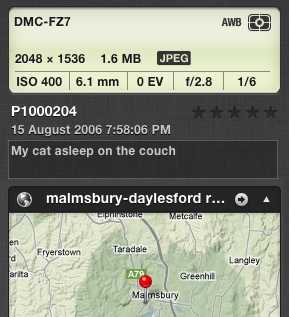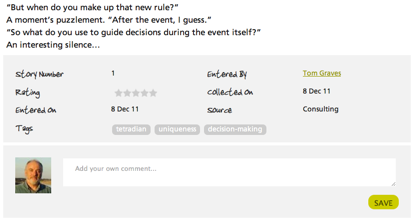Don’t forget the metadata!
How do we know which stories to use, and for what purpose? What would each story mean, in real-world practice?
The answers to those questions often reside not in the story itself, but in the other information that we collate around that story – in other words, what’s known as the metadata for the story.
Think of all those old photographs you have around the house: it’s often difficult to remember when and where they were taken, who’s shown each photograph, what was happening at the time, and so on. To make sense of it, we need information about the context of the photograph – the metadata. So to help us with this, most modern cameras will automatically record the metadata for the photograph itself – such as camera-type, image-size, filename and file-type, film-speed, shutter-speed, date, time, and even the location – to which we can often add our own comments as well. This example of photo-metadata is as shown in iPhoto, on the Mac:
For stories in our story-bank, Zahmoo helps us in much the same way. It can’t automatically create much of our story-metadata, of course, but it does remind us to do so ourselves. For example, when you enter a new text-story, Zahmoo provides some extra fields below the main text-box on the entry-form:
Tags help you to identify categories, places, people, anything else you need. There are no predefined tags, so make them up in any way that you want. They should usually be single words, or at most a couple of words linked by hyphens or spaces. On the form, use commas to separate the tags. Note that Zahmoo stores tags as lower-case only, hence ‘Family’ and ‘family’ are regarded as the same.
The Collected-on date defaults to the current date, but you can change this if you need.
The Source field is a place to record where the story came from: a family- or team-member, perhaps, or a genealogy-archive, a website or a company anecdote-circle session. Again, these are only suggestions: it’s up to you how you use this field.
The Confirmed checkbox is set by default anyway, so you can think of it as optional. Its purpose is to give you somewhere to flag that a story-source needs to be confirmed, or the story itself fact-checked before re-use. Probably not relevant for a family story-bank, but often very useful for a business story-bank.
The person who posted the story, and also the person you’ve tasked as administrator for your story-bank, can edit these fields at any time. (Look for the small ‘edit’-icon shown to the left-side of the story in story-lists.) For everyone else, they’re read-only.
When stories are displayed in Zahmoo, this metadata is shown below the respective story:
You’ll see that there are two more metadata items there, that any registered story-bank member can use: ratings and comments.
The Rating for a story is a simple five-point scale: click on the stars to select a one-star to five-star rating. Once again, there are no predefined rules about this: how you use story-ratings is up to you and your story-bank members. To save your rating, click on the ‘Save’ button below the ‘Comments’ field – you can do this even if there’s no comment to save.
There are many different ways to use story-Comments. For example, use comments to let story-bank members comment on the story itself, or perhaps to keep track of how and when a story has been used in community events or business marketing-campaigns. Each comment is shown with the comment-author’s current photograph, as stored in their personal profile: that’s shown as a preview on the left-side of this form. Click the ‘Save’ button to attach your comment to the story-record.
Zahmoo provides you with some useful tools to manage your metadata: but it’s up to you to use them. So don’t forget the metadata! – that information can be almost as important as the story itself.
Filed in: For Business, For Community, For Family, How to
Permalink | Comments Off on Don’t forget the metadata!



